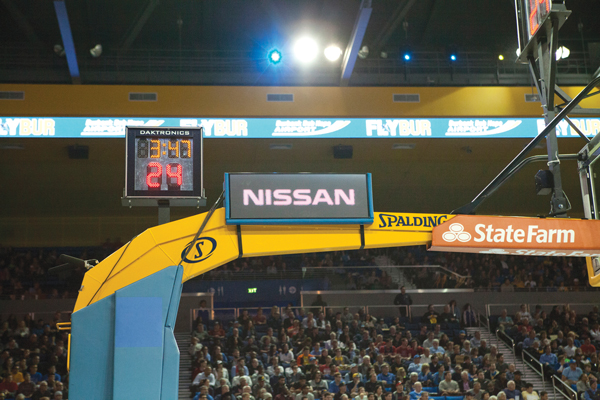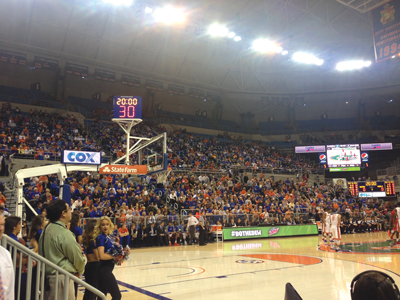 |
At UCLA (above) and Florida, LED signs 1 foot tall by 3 feet long sit behind the baskets.
Photo by: IMG (2)
|
A new revenue stream is flowing onto college campuses now that schools can install LED displays on basketball stanchions, thanks to a recent rules change by the NCAA.
More than 40 schools installed the LED boards, which sit next to State Farm’s ubiquitous red padding, at college arenas for the 2015-16 season. Those new digital boards represent lucrative TV-visible signage and high-profile inventory for schools and their rights holders.
State Farm’s branded signage on the basket has been a fixture in college basketball arenas for a decade, but the new LED signage — 1 foot tall by 3 feet long — goes a step beyond with the digital screens’ ability to change sponsors and their logos throughout the game.
It’s also another indication of how LED display manufacturers like Daktronics and ANC are leveraging unsold courtside spaces.
At the University of Arkansas, rights holder IMG College has generated six figures in revenue in the first year of selling ads on the small screens, said Chris Freet, the school’s senior associate athletic director for external relations.
Advertising time on the LED signage is mostly sold as part of a larger ad buy from corporate sponsors, and the stanchion displays often match up with the courtside signs and ribbon boards to create a comprehensive and synchronized message for sponsors.
The trend isn’t entirely new. For three seasons now, Time Warner Cable Arena, home of the Charlotte Hornets, has had stanchion LED boards, and the majority of NBA arenas have the displays, including Madison Square Garden and Oracle Arena, said officials involved in the marketing of those displays.
But NCAA rules restricted the use of LED displays on the stanchion until a change was made last year, enabling the LED boards to trickle down to college facilities. The NCAA’s basketball rules committee, chaired by Belmont University coach Rick Byrd, was responsible for lifting the restriction to now permit LED displays behind the basket.
They weren’t permitted in the past because they were considered by the committee to be a distraction to the shooter. So in Rule 1, Section 13, Article 5, the NCAA created a list of guidelines for the installation and use of the LED displays (see box). Among the rules: The LED boards can be lit at only 50 percent of their maximum brightness, and they have to be at least 6 feet removed from the baseline.
“It wasn’t an advertising policy. It was a rules issue,” said Mark Lewis, the NCAA’s executive vice president for championships and alliances.
Light it up
NCAA rules now permit LED signage on basket stanchions, but it must follow these guidelines:
■ Signage is permitted on the horizontal arm of the stanchion, but not vertically.
■ Signage must remain static during play and can change only during timeouts or between periods.
■ Signage must be 6 feet behind the baseline.
■ Signage must be installed with Safety Plex covering.
■ Signage can have up to two sides and cannot face toward the court.
■ Signage cannot be lit at more than 50 percent of maximum brightness.
Source: NCAA basketball Rule 1, Section 13, Article 5
After the NCAA approved the measure, many schools took action this season to install the boards on the basket supports, according to their rights holders. IMG College said about 28 of its clients have them, while Learfield estimated 15 of its schools have the displays.
“It’s become a real popular item due to the camera shots on television and the spectator views,” said Charley Bocklet, Daktronics’ regional sales manager for the Mid-Atlantic and New England. “For those schools getting new center-hungs, it’s been an automatic add-on as part of their purchase. It’s becoming more standardized than just a secondary piece.”
The boards were prevalent for the 2015-16 regular season and some conference tournaments. Scoreboard manufacturer Daktronics produced roughly 40 stanchion displays for 11 schools, many of which were IMG College accounts, in addition to the Ohio Valley Conference basketball tournament at Nashville’s Municipal Auditorium. The stanchion boards are not in use for the NCAA tournament, Lewis said.
NanoLumens is another manufacturer producing and selling the stanchion boards.
The model for purchasing and installing those displays, as well as selling space, differs depending on the school.
Some were direct sales to schools like Creighton, while others were bought by IMG College for its clients. In Arkansas’ case, the school bought the LED signage from Daktronics as part of a larger six-board purchase — IMG College will reimburse the school for the stanchion display.
Van Wagner installed the boards for most of the IMG College schools, just as the company did for many of the NBA arenas. IMG then sells the advertising time on the stanchion displays typically in one- or two-minute increments.
Learfield-owned ANC Sports, meanwhile, has produced video software systems for stanchion boards at about 15 college venues, mostly Learfield schools, said Jerry Cifarelli, the firm’s president and CEO. Learfield, like IMG, sells the ad time for its schools that have the stanchion boards.
At Creighton, the school’s multimedia rights are managed in-house, so the Big East institution purchased the stanchion boards directly from Daktronics and worked with a local installer for a total cost of $34,000, said Tim Callahan, director of sales for the Blue Jays.
Creighton sold the space on the boards, and without disclosing specific numbers, the school generated revenue over and above its investment in the first year, Callahan said. That’s not always been the case with arena signage at CenturyLink Center, where Creighton plays its home games and shares advertising inventory with the publicly owned facility.
“It’s been a great addition for us,” Callahan said. “I’ve DVR’d Creighton games on television and these boards are getting great exposure. It’s opened up some national sponsorships for us in Omaha. Jimmy John’s has jumped on board with us as well as Raising Cane’s, another national brand.”
At Arkansas, the SEC school purchased the stanchion boards from Daktronics as part of upgrading video boards at multiple sports venues on campus, including a new center-hung board at Bud Walton Arena. As part of its agreement with IMG College, the school will bill its rights holder for the cost of the stanchion boards at the end of the fiscal year, Freet said.
“We’re fortunate in that we’re in the fourth year of a revenue share in which IMG has already exceeded their guarantee to us,” he said. “The stanchion boards have helped in that respect.”
The stanchion displays provide another piece of the puzzle for marketers to sell with center-hungs, courtside signs and LED boards rimming the seating bowl — even Daktronics’ customized LED screens attached to the structural roof columns at Rutgers Athletic Center.
In the future, the basket stanchion itself could evolve into a fully digital board, keeping in mind the restrictions set forth by the NBA and NCAA. On its own, ANC is testing different displays, including a stanchion blanketed with LED technology, Cifarelli said.
Separately, ANC has signed a deal with Times Square Media Strategies to integrate its 3-D projection mapping system into sports facilities, and officials see that technology potentially working its way into LED displays.
“It’s all about being creative in a classy, constructive way,” Cifarelli said. “That’s where we’re going. With one click of an icon, the images play inside and outside [the venue], all synchronized. That’s the growth of digital signs in the arena business. Stanchions are just an add-on to a bigger package.”





